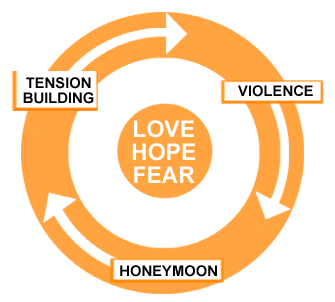The Cycle of Violence
The cycle of domestic violence has three phases: Tension Building, Explosion and Honeymoon. Each stage lasts a different amount of time and the order of the phases may vary. Abusing tends to be a pattern of violence that repeats itself over days, months or years and not a one time event.

Tension Building
Tension building phase may last anywhere from one day to several years. This phase usually happens more frequently as the cycle is repeated and the abuse gets worse.
The abuser may: | The victim may: |
- Act jealous or possessive
- Argue or pick fights
- Be demanding
- Have a quick temper
- Blame her for his problems
- Be moody and unpredictable
- Criticize or threaten
| - Feel like she's walking on eggshells
- Try not to make him angry
- Try to stay quiet, keep the children quiet
- Feel afraid or anxious
- Accept blame
- Try to calm the abuser
|
Explosion Phase
Explosion phase may be verbal, physical or both. The abuser has complete control during this phase. This is the most violent and dangerous phase; the victims life is in danger.
The abuser may: | The victim may: |
- Hit, slap or punch
- Kick
- Choke
- Pull hair
- Destroy property or the phone
- Use objects or weapons
- Keep the victim from leaving
- Force the victim to have sex
- Yell and call the victim names
| - Feel fear and shock
- Try to protect herself and children
- Call for help
- Feel out of touch with her body
- Pray for it to stop
- Try to escape
- Try any means of self defensive
- Do what is necessary to survive
|
Honeymoon Phase
Honeymoon phase tends to be shorter than the tension building phase and may disappear completely over time. The batterer goes back to acting like his “charming” self but rarely admits blame for the violence.
The abuser may: | The victim may: |
- Beg for forgiveness
- Promise never to do it again
- Act charming and caring
- Blame drugs or alcohol
- Give gifts
- Promise to get help
- Blame other people for his actions
- Initiate intimacy or sex
- Give his partner hope that he will change.
| - Forgive the abuser
- Return home
- Blame herself for the abuse
- Minimize or deny what happened
- Feel manipulated
- Feel like she has no other options but to stay
- Feel exhausted and emotionally worn out
- Have hope that he will change
|